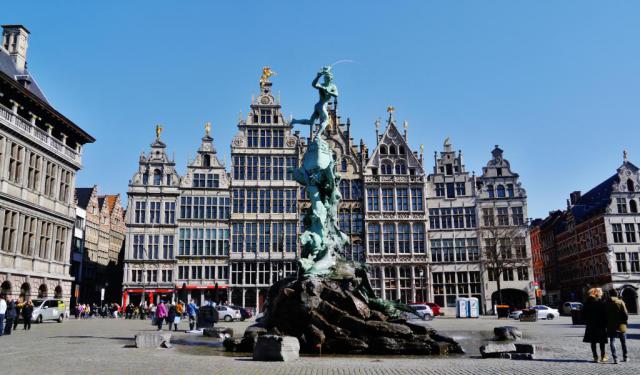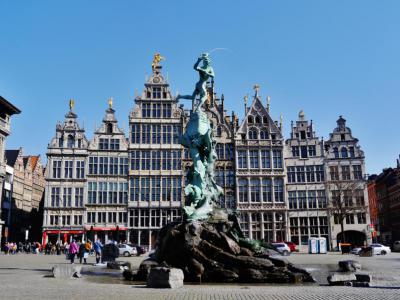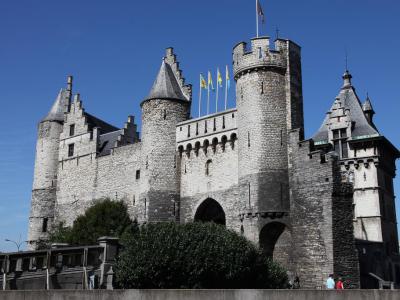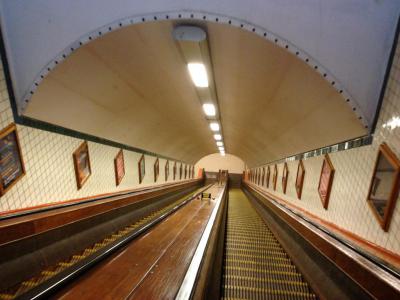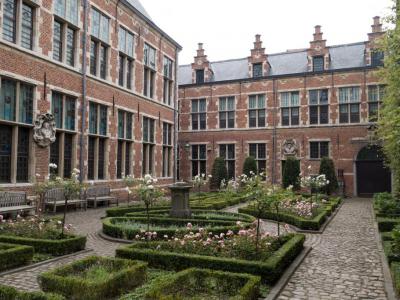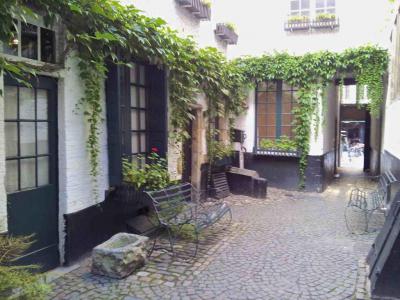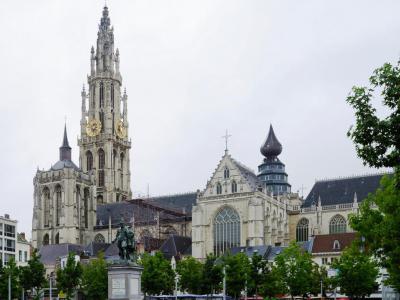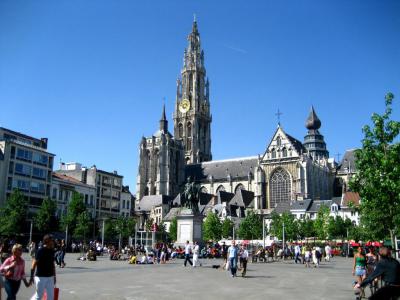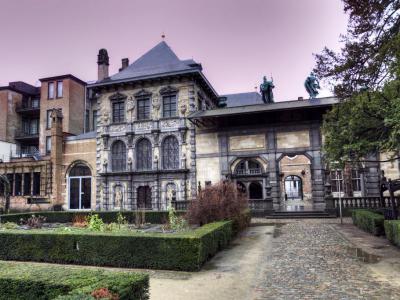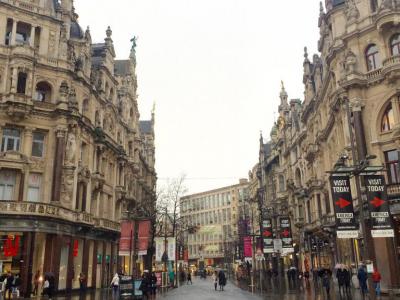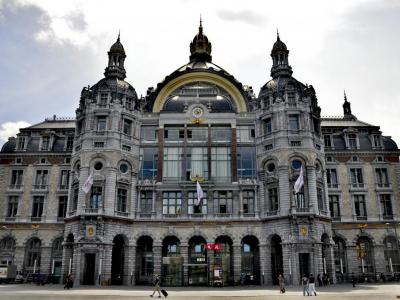Antwerp Introduction Walking Tour (Self Guided), Antwerp
A major city-port on the River Scheldt in Belgium, Antwerp is known primarily as the diamond capital of Europe. For centuries, Antwerp's Diamond District has been the center of diamond trade, with thousands of dealers, cutters and polishers processing 85% of the world's rough diamonds each year.
Historical Antwerp has its origins in a Gallo-Roman settlement, first mentioned in the 4th century AD. The actual translations of its name range from the “land thrown up at the riverbank” (Andhunerbo) or “on the wharf” (an t werf), in old German, to the Celtic “Andoverpis” – possibly meaning "those who live on both banks".
However, a folklore legend celebrated by statue in the city's main market square, the Grote Markt, holds that a mythical giant once lived near the river Scheldt and extracted toll from passing boatmen under the threat of cutting their hands off. Eventually, the giant was slain by a young hero, who cut off his hand and threw it into the river; hence the name Antwerpen from Dutch hand werpen (“hand-throwing”).
Both economically and culturally, Antwerp has long been an important city in the Low Countries. The Bourse of Antwerp, originally built in 1531 and re-built in 1872, was the world's first purpose-built commodity exchange. The city is also famous for its Flemish Renaissance architecture and close association with the 17th-century Flemish Baroque painter, Peter Paul Rubens, whose house is now a museum.
Among other landmarks here are:
Het Steen – a medieval fortress in the Old Town, built after the Viking incursions in the early Middle Ages.
Plantin-Moretus Museum – a real gem and the only museum in the world recognized as a UNESCO World Heritage Site.
Vlaeykensgang – a historic maze of small alleys, offering an idyllic refuge from the hubbub of the city center.
Cathedral of Our Lady – the highest Gothic building in the Low Countries; richly adorned with the Rubens paintings.
Antwerpen-Centraal – the Antwerp Central Station, one of the city’s main landmarks, and one of the most beautiful train stations in the world.
Antwerp is a reasonably-sized city, with most places of interest located close by to one another. It is therefore best explored on foot. If you wish to discover the most prominent attractions of Antwerp in a relaxed manner, take this self-guided walk and get to know the city at your own pace.
Historical Antwerp has its origins in a Gallo-Roman settlement, first mentioned in the 4th century AD. The actual translations of its name range from the “land thrown up at the riverbank” (Andhunerbo) or “on the wharf” (an t werf), in old German, to the Celtic “Andoverpis” – possibly meaning "those who live on both banks".
However, a folklore legend celebrated by statue in the city's main market square, the Grote Markt, holds that a mythical giant once lived near the river Scheldt and extracted toll from passing boatmen under the threat of cutting their hands off. Eventually, the giant was slain by a young hero, who cut off his hand and threw it into the river; hence the name Antwerpen from Dutch hand werpen (“hand-throwing”).
Both economically and culturally, Antwerp has long been an important city in the Low Countries. The Bourse of Antwerp, originally built in 1531 and re-built in 1872, was the world's first purpose-built commodity exchange. The city is also famous for its Flemish Renaissance architecture and close association with the 17th-century Flemish Baroque painter, Peter Paul Rubens, whose house is now a museum.
Among other landmarks here are:
Het Steen – a medieval fortress in the Old Town, built after the Viking incursions in the early Middle Ages.
Plantin-Moretus Museum – a real gem and the only museum in the world recognized as a UNESCO World Heritage Site.
Vlaeykensgang – a historic maze of small alleys, offering an idyllic refuge from the hubbub of the city center.
Cathedral of Our Lady – the highest Gothic building in the Low Countries; richly adorned with the Rubens paintings.
Antwerpen-Centraal – the Antwerp Central Station, one of the city’s main landmarks, and one of the most beautiful train stations in the world.
Antwerp is a reasonably-sized city, with most places of interest located close by to one another. It is therefore best explored on foot. If you wish to discover the most prominent attractions of Antwerp in a relaxed manner, take this self-guided walk and get to know the city at your own pace.
How it works: Download the app "GPSmyCity: Walks in 1K+ Cities" from Apple App Store or Google Play Store to your mobile phone or tablet. The app turns your mobile device into a personal tour guide and its built-in GPS navigation functions guide you from one tour stop to next. The app works offline, so no data plan is needed when traveling abroad.
Antwerp Introduction Walking Tour Map
Guide Name: Antwerp Introduction Walking Tour
Guide Location: Belgium » Antwerp (See other walking tours in Antwerp)
Guide Type: Self-guided Walking Tour (Sightseeing)
# of Attractions: 10
Tour Duration: 2 Hour(s)
Travel Distance: 3.5 Km or 2.2 Miles
Author: mary
Sight(s) Featured in This Guide:
Guide Location: Belgium » Antwerp (See other walking tours in Antwerp)
Guide Type: Self-guided Walking Tour (Sightseeing)
# of Attractions: 10
Tour Duration: 2 Hour(s)
Travel Distance: 3.5 Km or 2.2 Miles
Author: mary
Sight(s) Featured in This Guide:
- Grote Markt (Great Market Square)
- Het Steen (Steen Castle)
- St. Anna Tunnel
- Plantin-Moretus Museum
- Vlaeykensgang Historic Alley
- Cathedral of Our Lady
- Groenplaats (Green Square)
- Rubenshuis (Rubens House)
- Meir Shopping Street
- Antwerpen-Centraal (Antwerp Central Station)
1) Grote Markt (Great Market Square) (must see)
Right in the heart of the city, the Great Market Square is one of the favorite locations for locals as well as tourists. Filled with cafés and restaurant, the Great Market Square is a popular destination if you want to just kick back, bask in the sun with a chilled glass of beer or stroll around lazily admiring the architecture of the city. Dominated by the elegant and grant Renaissance style City Hall on one side and a row of guild houses and old patrician houses on the other, the Great Market Square is a magnet for those who love studying city architecture.
The center of the square holds the magnificent fountain that bears the well sculpted statue of Silvius Brabo, the local mythical hero. As legend has it, the water way was once governed by a giant who demanded a high toll from those who wanted to enter the city. Those failing to meet the requirements, were punished by having their hand cut off. It was Brabo, who fought the giant and cut off his hand and threw it in the Scheldt river.
One of the best ways to enjoy a perfect day in Antwerp is to sit in an open terrace restaurant amidst the elegantly constructed buildings of the Great Market Square, have an authentic Belgian meal on the table and admire the city as it moves past you.
The center of the square holds the magnificent fountain that bears the well sculpted statue of Silvius Brabo, the local mythical hero. As legend has it, the water way was once governed by a giant who demanded a high toll from those who wanted to enter the city. Those failing to meet the requirements, were punished by having their hand cut off. It was Brabo, who fought the giant and cut off his hand and threw it in the Scheldt river.
One of the best ways to enjoy a perfect day in Antwerp is to sit in an open terrace restaurant amidst the elegantly constructed buildings of the Great Market Square, have an authentic Belgian meal on the table and admire the city as it moves past you.
2) Het Steen (Steen Castle)
Steen Castle (Het Steen), nestled in the historic center of Antwerp, is a medieval fortress with roots extending back to the early 13th century. Originally constructed between 1200 and 1225, it served as a gateway to a more extensive castle complex belonging to the Dukes of Brabant, which unfortunately was demolished in the 19th century. This makes Steen Castle the oldest surviving building in Antwerp and a rare remnant of the city’s earliest stone fortifications.
The fortress's primary role was to control access to the Scheldt River, a crucial economic and strategic waterway for the city, which was one of Europe's largest ports. Steen Castle has undergone several transformations through the centuries. Initially known as Antwerp Castle and later renamed around 1520 following significant renovations under Charles V, it evolved from a royal residence to a local administrative hub. From 1303 to 1827, it functioned as a prison and later housed the city's Alderman's house and court of justice.
By the 19th century, much of the original fortress was demolished for urban development and to prevent the silting of the Scheldt, leaving only part of the structure that was turned into a shipping museum. In 1890, it became an archaeological museum, and by 1952, an annex was added to highlight Antwerp's maritime history. This collection moved to the Museum Aan de Stroom in 2011. The site also features a war memorial dedicated to Canadian soldiers from World War II.
The cultural heritage continues to be celebrated at Steen Castle, evident in the bas-relief of Semini, a Scandinavian god of youth and fertility, positioned above the entrance archway. Additionally, a nearby statue portrays the folklore giant Lange Wapper, who is said to have terrorized medieval Antwerp.
Recently, in October 2021, Steen Castle underwent significant renovations, reopening as a modern visitor center that blends its ancient architecture with contemporary design. This revitalization aims to enhance the visitor experience while preserving the historical and cultural significance of one of Antwerp’s most storied landmarks.
The fortress's primary role was to control access to the Scheldt River, a crucial economic and strategic waterway for the city, which was one of Europe's largest ports. Steen Castle has undergone several transformations through the centuries. Initially known as Antwerp Castle and later renamed around 1520 following significant renovations under Charles V, it evolved from a royal residence to a local administrative hub. From 1303 to 1827, it functioned as a prison and later housed the city's Alderman's house and court of justice.
By the 19th century, much of the original fortress was demolished for urban development and to prevent the silting of the Scheldt, leaving only part of the structure that was turned into a shipping museum. In 1890, it became an archaeological museum, and by 1952, an annex was added to highlight Antwerp's maritime history. This collection moved to the Museum Aan de Stroom in 2011. The site also features a war memorial dedicated to Canadian soldiers from World War II.
The cultural heritage continues to be celebrated at Steen Castle, evident in the bas-relief of Semini, a Scandinavian god of youth and fertility, positioned above the entrance archway. Additionally, a nearby statue portrays the folklore giant Lange Wapper, who is said to have terrorized medieval Antwerp.
Recently, in October 2021, Steen Castle underwent significant renovations, reopening as a modern visitor center that blends its ancient architecture with contemporary design. This revitalization aims to enhance the visitor experience while preserving the historical and cultural significance of one of Antwerp’s most storied landmarks.
3) St. Anna Tunnel
The Saint Anna Tunnel in Antwerp is an impressive engineering achievement and a unique historical site. Situated under the Scheldt River, which bisects the city, this tunnel provides a pedestrian and bicycle passage connecting the old town with newer areas across the river.
Constructed in 1931, the tunnel was built as an alternative to a bridge which would have disrupted the heavy ship traffic crucial to Antwerp's port activities. Spanning 572 meters in length and situated 31.57 meters below the river’s surface, the tunnel features a remarkable installation of wooden escalators. These escalators, dating back to the 1930s, are not only a rarity but are also beautifully preserved, contrasting starkly with the modern escalators found in most contemporary settings.
Visitors descending into the tunnel are greeted by the warm glow of its original wooden escalators, leading deep beneath the river. The journey through the tunnel is lined with ceramic tiles, offering a somewhat monotonous backdrop that is periodically interrupted by historical photographs and informational displays about the tunnel's construction and its role in the city's development.
Despite suffering significant damage during World War II, the Saint Anna Tunnel has been carefully restored and continues to serve as a vital conduit for daily commuters. Its historical significance and the continued use of its original features, like the wooden escalators and staircase, make it a special destination for those interested in both the past and present of urban infrastructure.
Constructed in 1931, the tunnel was built as an alternative to a bridge which would have disrupted the heavy ship traffic crucial to Antwerp's port activities. Spanning 572 meters in length and situated 31.57 meters below the river’s surface, the tunnel features a remarkable installation of wooden escalators. These escalators, dating back to the 1930s, are not only a rarity but are also beautifully preserved, contrasting starkly with the modern escalators found in most contemporary settings.
Visitors descending into the tunnel are greeted by the warm glow of its original wooden escalators, leading deep beneath the river. The journey through the tunnel is lined with ceramic tiles, offering a somewhat monotonous backdrop that is periodically interrupted by historical photographs and informational displays about the tunnel's construction and its role in the city's development.
Despite suffering significant damage during World War II, the Saint Anna Tunnel has been carefully restored and continues to serve as a vital conduit for daily commuters. Its historical significance and the continued use of its original features, like the wooden escalators and staircase, make it a special destination for those interested in both the past and present of urban infrastructure.
4) Plantin-Moretus Museum (must see)
One of the most fascinating museums one can encounter in Antwerp is the Plantin-Moretus Museum. Home to one of the most prolific printing presses of the 16th and 17th century, the Platin–Moretus Museum is a must visit in Antwerp.
Founded by Christoffel Plantin, a Frenchman who from being a mere bookbinder became the most noted publisher and printer of the Renaissance period, the printing press was one of the key factors in establishing Antwerp as one of Europe’s leading cities with regard to the spread of typography and inventions in printing technology. Plantin’s son-in-law, Jan Moretus, played a vital role in bringing newer technologies and inventions to the press after the death of Plantin.
After running successfully for over two centuries the company was sold to the city of Antwerp in 1876. The Museum is located in the former residence and printing establishment of the Platin–Moretus family. Its location is listed as a World Heritage Site by UNESCO.
The Museum houses some of the world’s oldest surviving printing presses and some extraordinary tools, dyes and matrices that were in use. The most prized possession of the Museum remains the extensive library and antique books that are a century or two old. Also noteworthy are the rich and elaborate interiors and the architecture of the building that speak of the opulence of the Platin-Moretus family.
Founded by Christoffel Plantin, a Frenchman who from being a mere bookbinder became the most noted publisher and printer of the Renaissance period, the printing press was one of the key factors in establishing Antwerp as one of Europe’s leading cities with regard to the spread of typography and inventions in printing technology. Plantin’s son-in-law, Jan Moretus, played a vital role in bringing newer technologies and inventions to the press after the death of Plantin.
After running successfully for over two centuries the company was sold to the city of Antwerp in 1876. The Museum is located in the former residence and printing establishment of the Platin–Moretus family. Its location is listed as a World Heritage Site by UNESCO.
The Museum houses some of the world’s oldest surviving printing presses and some extraordinary tools, dyes and matrices that were in use. The most prized possession of the Museum remains the extensive library and antique books that are a century or two old. Also noteworthy are the rich and elaborate interiors and the architecture of the building that speak of the opulence of the Platin-Moretus family.
5) Vlaeykensgang Historic Alley
Great Market Square in itself gives you a glimpse of life in Antwerp as it was a few centuries ago. Parallel to the Square are several alleys that manage to reflect the lifestyle, ambiance and feel of the years gone by as they are still preserved and almost untouched by the hands of time. One such place is Vlaeykensgang, and the entrance to this alley is through a small doorway.
Easy to overlook, once found this alley will transport you to the 16th century. A perfect place to walk and get the true feel of the city, the Vlaeykensgang is filled with authentic peasant houses and residential complexes.
Although today, these may seem like the perfect refuge from the urbanization and the pace of city life, back in those days, these alleys were not considered as places suitable for living. Cramped up and over populated with large families, poor sanitation are just some of the problems one faced here. However today, Vlaeykensgang is looked at as an idealistic and artistic refuge from the hectic city life.
Easy to overlook, once found this alley will transport you to the 16th century. A perfect place to walk and get the true feel of the city, the Vlaeykensgang is filled with authentic peasant houses and residential complexes.
Although today, these may seem like the perfect refuge from the urbanization and the pace of city life, back in those days, these alleys were not considered as places suitable for living. Cramped up and over populated with large families, poor sanitation are just some of the problems one faced here. However today, Vlaeykensgang is looked at as an idealistic and artistic refuge from the hectic city life.
6) Cathedral of Our Lady (must see)
Overlooking the city of Antwerp since the 14th century is the beautiful Cathedral of Our Lady, which till date dominates the city’s skyline. Built by architects Jan and Pieter Appelmans, the Cathedral boasts a magnificent Gothic structure with hints of Baroque style complementing the interiors of the building.
Whether you are a history buff or an admirer of architecture, the Cathedral of Our Lady is one structure that has something to offer every visitor. The structure stands as the epitome of the perfect combination of artistic architecture, breathtaking interiors and a dramatic past making it a tantalizing site to visit.
Although the construction of the structure began in 1352, it took more than a century to complete the entire construction. The Cathedral that stands today rests on the same site where once stood a small chapel dedicated to Our Lady. The chapel traced its history to early 10th century and it was subsequently followed by the construction of a Romanesque Church.
The Gothic Cathedral that took its place was considered one of the most magnificent structures of its time and one of the largest cathedrals in the whole of Benelux. However despite all its glories, the Cathedral of Our Lady has faced a very turbulent past. From natural fires to raids, plunders and assault by iconoclasts, the structure has born tremendous damage over the years. But it has stood the test of time and stands proudly today in the city of Antwerp.
Whether you are a history buff or an admirer of architecture, the Cathedral of Our Lady is one structure that has something to offer every visitor. The structure stands as the epitome of the perfect combination of artistic architecture, breathtaking interiors and a dramatic past making it a tantalizing site to visit.
Although the construction of the structure began in 1352, it took more than a century to complete the entire construction. The Cathedral that stands today rests on the same site where once stood a small chapel dedicated to Our Lady. The chapel traced its history to early 10th century and it was subsequently followed by the construction of a Romanesque Church.
The Gothic Cathedral that took its place was considered one of the most magnificent structures of its time and one of the largest cathedrals in the whole of Benelux. However despite all its glories, the Cathedral of Our Lady has faced a very turbulent past. From natural fires to raids, plunders and assault by iconoclasts, the structure has born tremendous damage over the years. But it has stood the test of time and stands proudly today in the city of Antwerp.
7) Groenplaats (Green Square)
Antwerp is the perfect destination if you love to laze around on a warm summer’s day under the sun or enjoy watching the city from the comfort of a cozy café. Yet another famous square in Antwerp is the Green Square. Although not as green as the name suggests, the Green Square, is a popular destination amongst both tourists and locals during summer and on weekends.
Overlooking the Square in the north is the elegant Cathedral of Our Lady. Back in the medieval times, the Green Square was used as a cemetery that was attached to the Cathedral. With the Austrian occupation of Antwerp in the 18th century, Emperor Joseph II abolished cemeteries within the walls of the city. Although the premises were then converted to a square for town use, the age old name couldn’t get converted and locals still call it Green Place.
Today the center of the square is dominated by the statue of the much loved Flemish painter Sir Peter Paul Rubens. Installed in 1843, this bronze statue replaced a crucifix that overlooked the cemetery. Created by sculptor Willem Geefs, the statue commemorated death bicentenary of the city’s beloved artist.
Overlooking the Square in the north is the elegant Cathedral of Our Lady. Back in the medieval times, the Green Square was used as a cemetery that was attached to the Cathedral. With the Austrian occupation of Antwerp in the 18th century, Emperor Joseph II abolished cemeteries within the walls of the city. Although the premises were then converted to a square for town use, the age old name couldn’t get converted and locals still call it Green Place.
Today the center of the square is dominated by the statue of the much loved Flemish painter Sir Peter Paul Rubens. Installed in 1843, this bronze statue replaced a crucifix that overlooked the cemetery. Created by sculptor Willem Geefs, the statue commemorated death bicentenary of the city’s beloved artist.
8) Rubenshuis (Rubens House) (must see)
Known for his Counter Reformation portraits, landscapes and paintings, Sir Peter Paul Rubens was a Baroque painter, book illustrator and a diplomat during the early 1600s. The Rubens House is a city of Antwerp-owned and curated building that Rubens designed himself and spent most of his lifetime in.
Located on Wapper Street, Rubens purchased this house in 1610 and added a gallery, porch and a large studio in Greco-Roman classic styles and a hint of Italian Renaissance to the structure. Within the walls of this house, Rubens and his students, such as Anthony Van Dyck and Jacob Jordaens, created most of their works. Rubens’ work is categorized by various stages of productivity of his own life. However, all of Rubens’ work that is on display in the House today came back only after great efforts were put in by the people of Antwerp once it was decided to make the building into a monument in 1937.
The Rubens House is home to paintings such as Saint Claire of Assisi, The Annunciation and Adam and Eve made by the great painter himself in addition to the works of other contemporaries of his time. The House also displays various objects of art from the 17th century giving visitor a peek at the lavish lifestyles of those times. The Renaissance Garden which was renovated in 1993 takes inspiration from Rubens’ paintings and should not be missed.
Located on Wapper Street, Rubens purchased this house in 1610 and added a gallery, porch and a large studio in Greco-Roman classic styles and a hint of Italian Renaissance to the structure. Within the walls of this house, Rubens and his students, such as Anthony Van Dyck and Jacob Jordaens, created most of their works. Rubens’ work is categorized by various stages of productivity of his own life. However, all of Rubens’ work that is on display in the House today came back only after great efforts were put in by the people of Antwerp once it was decided to make the building into a monument in 1937.
The Rubens House is home to paintings such as Saint Claire of Assisi, The Annunciation and Adam and Eve made by the great painter himself in addition to the works of other contemporaries of his time. The House also displays various objects of art from the 17th century giving visitor a peek at the lavish lifestyles of those times. The Renaissance Garden which was renovated in 1993 takes inspiration from Rubens’ paintings and should not be missed.
9) Meir Shopping Street (must see)
Meir is a famous shopping destination for the city of Antwerp and, along with the New Street in Brussels, one of the most important shopping areas in Belgium. The Meir shopping district encompasses the streets surrounding Our Lady’s Cathedral all the way to the Central Station. Once used to store wet wood for furniture, the area has come a long way to be recognized as one of the prime areas for shopping in the country. Once being a small street on the outskirts of the city, today Meir is an integral part of the city center.
With the opening of the Stadsfeestzaal Shopping Centre in 2007, the Meir has become the most expensive shopping destination in the economic union of Benelux. The area is home to all major shopping brands and attracts over 200,000 visitors from neighboring states and other European countries.
Along with being a shopping capital, the Meir has also seen the richness of architecture and the lavishness of the rich. It is home to some exquisite buildings such as ‘Osterrieth House’ at number 85 and the Royal Residence of the Belgian Kings, both built in the old Rococo style by architect Van Baurscheit. Whether for a shopping experience or just visiting to catch a glimpse of the past, Meir is a place that all must visit.
With the opening of the Stadsfeestzaal Shopping Centre in 2007, the Meir has become the most expensive shopping destination in the economic union of Benelux. The area is home to all major shopping brands and attracts over 200,000 visitors from neighboring states and other European countries.
Along with being a shopping capital, the Meir has also seen the richness of architecture and the lavishness of the rich. It is home to some exquisite buildings such as ‘Osterrieth House’ at number 85 and the Royal Residence of the Belgian Kings, both built in the old Rococo style by architect Van Baurscheit. Whether for a shopping experience or just visiting to catch a glimpse of the past, Meir is a place that all must visit.
10) Antwerpen-Centraal (Antwerp Central Station) (must see)
Antwerp is a perfect blend of old and new, renowned for its great effort in preserving historic buildings. One such building is the Antwerp Central Station, aka Middenstatie (Middle station). The latter name – now an antiquated expression in Dutch – is seen on the plaque fixed on the north wall of the Station.
A key landmark in the city, this mighty edifice is one of the finest examples of railway architecture in Belgium. It's been repeatedly voted among the world’s most impressive railway stations, including number four in 2009 by the U.S. Newsweek magazine, and number one in 2014 by the British-American magazine Mashable.
The original stone-clad structure, with a steel platform covering, was designed by Louis Delacenserie. It was built between 1895 and 1905 as a replacement for the first terminus of the Brussels-Mechelen-Antwerp railway.
Because of its unique architecture, historians still struggle to attribute the Antwerpen-Centraal to any particular style. The eclectic mix features a Neo-Gothic front, a massive dome over the iron-glass waiting hall, for which the building has been colloquially referred to as the "spoorwegkathedraal" ("railroad cathedral"), and a modern multilevel platform system. Another notable element, the viaduct leading into the Station, was designed by local architect, Jan Van Asperen.
During WWII, the train hall sustained severe damage by V-2 rockets, which is still visible today due to a lasting wave-distortion in the roof.
Recently, the Station was completely renovated, and in 2007 had an underground tunnel opened. Today it operates 14 railways tracts at four different terminals and plays a vital role in connecting various parts of Belgium.
If you're an architecture buff or railway enthusiast, having the Antwerpen-Centraal on your list of things to see is a must! But even if you're neither of these, we still recommend visiting it, just for the spectacle.
A key landmark in the city, this mighty edifice is one of the finest examples of railway architecture in Belgium. It's been repeatedly voted among the world’s most impressive railway stations, including number four in 2009 by the U.S. Newsweek magazine, and number one in 2014 by the British-American magazine Mashable.
The original stone-clad structure, with a steel platform covering, was designed by Louis Delacenserie. It was built between 1895 and 1905 as a replacement for the first terminus of the Brussels-Mechelen-Antwerp railway.
Because of its unique architecture, historians still struggle to attribute the Antwerpen-Centraal to any particular style. The eclectic mix features a Neo-Gothic front, a massive dome over the iron-glass waiting hall, for which the building has been colloquially referred to as the "spoorwegkathedraal" ("railroad cathedral"), and a modern multilevel platform system. Another notable element, the viaduct leading into the Station, was designed by local architect, Jan Van Asperen.
During WWII, the train hall sustained severe damage by V-2 rockets, which is still visible today due to a lasting wave-distortion in the roof.
Recently, the Station was completely renovated, and in 2007 had an underground tunnel opened. Today it operates 14 railways tracts at four different terminals and plays a vital role in connecting various parts of Belgium.
If you're an architecture buff or railway enthusiast, having the Antwerpen-Centraal on your list of things to see is a must! But even if you're neither of these, we still recommend visiting it, just for the spectacle.
Walking Tours in Antwerp, Belgium
Create Your Own Walk in Antwerp
Creating your own self-guided walk in Antwerp is easy and fun. Choose the city attractions that you want to see and a walk route map will be created just for you. You can even set your hotel as the start point of the walk.
Antwerp Historic Center Walk
Antwerp is a bustling metropolis, replete with modern entertainment, yet it is the centuries-old city center that fuels tourists' interest the most. Indeed, downtown Antwerp is steeped in history. So much so, in fact, that to see all that it has to offer, you'll need way more than one day.
Here history awaits you practically round every corner – seen in the ancient building-fronts... view more
Tour Duration: 2 Hour(s)
Travel Distance: 3.9 Km or 2.4 Miles
Here history awaits you practically round every corner – seen in the ancient building-fronts... view more
Tour Duration: 2 Hour(s)
Travel Distance: 3.9 Km or 2.4 Miles
Antwerp's Historical Churches Tour
Antwerp, a city steeped in history and culture, boasts an array of historical churches that stand as testaments to its past.
Reigning supreme among them is the Cathedral of Our Lady, a stunning 14th-century Gothic masterpiece. Its towering spire dominates the city skyline and houses invaluable artworks by renowned artists such as Peter Paul Rubens, Otto van Veen, Jacob de Backer, and Marten de... view more
Tour Duration: 2 Hour(s)
Travel Distance: 3.6 Km or 2.2 Miles
Reigning supreme among them is the Cathedral of Our Lady, a stunning 14th-century Gothic masterpiece. Its towering spire dominates the city skyline and houses invaluable artworks by renowned artists such as Peter Paul Rubens, Otto van Veen, Jacob de Backer, and Marten de... view more
Tour Duration: 2 Hour(s)
Travel Distance: 3.6 Km or 2.2 Miles
The Most Popular Cities
/ view all
